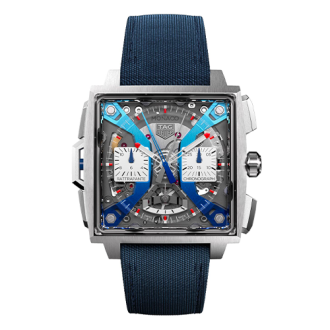It’s funny how some words just don’t seem to go together. Like “Haute Horlogerie” and “racing”, or “manual finishes” and “ultra-sporty”, for instance. But the truth is, the only limits are the ones we set for ourselves.
Perhaps TAG Heuer’s limits have been a little too rigid up to now. The brand has always shied away from creating a split-seconds Monaco. They had the traditional chronograph, and even a few flyback models, but never a split-seconds complication. Why the hesitation?
It may be because the split-seconds function is seen as very high-end, elite and refined – the preserve of prestigious manufactures like Patek Philippe or, more recently, A. Lange & Söhne, members of an exclusive club that TAG Heuer had never dared to apply to. Until now.
The Monaco Split-Seconds Chronograph shakes everything up. It’s one of the star pieces of Watches and Wonders 2024’s sports watch lineup. And it’s unusual in more ways than one. Let’s take a closer look.

A historic first for the Monaco
The Monaco has always been an unusual watch, with a somewhat chaotic trajectory. Unveiled in 1969, the brand (then just called “Heuer”) was ahead of its time – perhaps a little too much. That square, electric blue UFO of a watch initially received a rather mixed reception. Although the movement inside has since become legendary, at the time it didn’t quite live up to the watch’s ambitions. The defunct Calibre 11 was quickly replaced by the more reliable Calibre 12 but the original Monaco didn’t last long – it was too disruptive, too futuristic for its era.
When the Monaco was reintroduced in the early 90s, it was more in tune with the times and grew into the icon we know today. But throughout its history, the Monaco has remained a simple, affordable chronograph, without venturing too far into complicated watchmaking.
That changed in the summer of 2023, when TAG Heuer unveiled a one-of-a-kind Split-Seconds Monaco for the Only Watch charity auction. The auction ended up being cancelled and the watch went back in the drawer, but TAG Heuer was already working on a production version.

No in-house movement, but that’s okay
Now the Split-Seconds Monaco is joining the regular collection. As an integrated manufacture, you might expect TAG Heuer to have used one of their own movements. But that’s not the case – this model uses a movement supplied by Vaucher Manufacture. Should we be bothered by that? Not at all, and for three excellent reasons.
First, TAG Heuer is being transparent about its partnership with this prestigious movement-maker. That is rare and entirely commendable.
Second, developing a split-seconds chronograph movement from scratch is an enormous undertaking, requiring millions of francs and five to six years of work. TAG Heuer may well be doing that already, but it’s also a perfectly sensible idea to first test the complication with an external movement, if only to gauge its commercial viability before investing in an in-house version. That’s just practical common sense.
And lastly, there is no reason at all to throw a fit at the thought of a manufacture watch being fitted with a third-party calibre. This already happens in the vast majority of chronographs available today, which generally rely on base movements from the likes of ETA, Valjoux, Sellita, Soprod, Miyota or Vaucher, which is probably one of the best. Why make things difficult?

A true haute horlogerie timepiece
But the movement is just one part of the story. The entire Split-Seconds Monaco is decorated with exquisite manual finishes. “The chequered bridge on the caseback, for instance, requires over 30 hours of hand-engraving,” explains Carole Kasapi, head of movement development at TAG Heuer. “The case is also a custom design,” she continues. “How many other brands would develop a new case for a single model?”
The sculptural case is made of 100% sapphire, apart from the caseband. There’s no sapphire caseback inserted into a traditional metal case. This is a complete 3D case made out of hand-polished sapphire. And that’s not the only exceptional material. The calibre is made entirely from titanium, making it “the lightest automatic chronograph movement ever produced by TAG Heuer” in partnership with Vaucher Manufacture Fleurier, as the brand points out. “It weighs 30 grams,” Carole Kasapi notes.

So, the TAG Heuer Monaco Split-Seconds Chronograph is now part of the regular collection, but in very limited numbers, given its complex manufacturing process. Two versions will be available: one in red, the other in the Monaco’s iconic blue. Expect the price to be somewhere around 300,000 euros.








